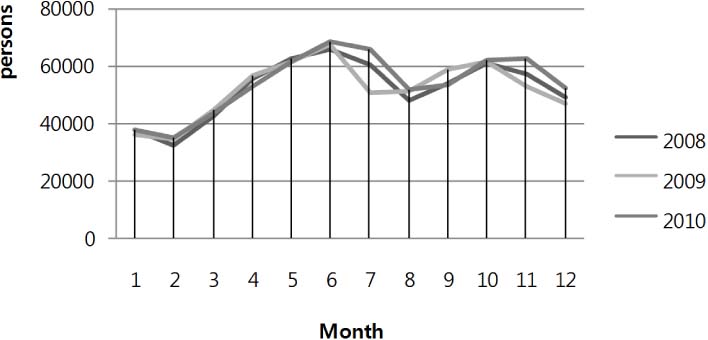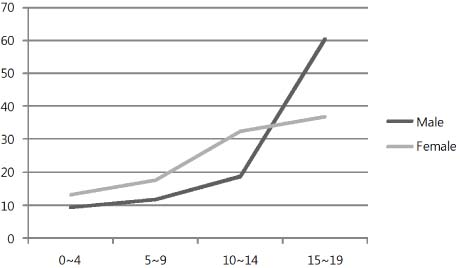J Korean Fract Soc.
2014 Oct;27(4):308-314. 10.12671/jkfs.2014.27.4.308.
The Pattern of Occurrence of Fractures in Children and Adolescents and Its Managements Based on the Database of the Health Insurance Review and Assessment Service
- Affiliations
-
- 1Department of Orthopedic Surgery, Inje University Busan Paik Hospital, Inje University College of Medicine, Busan, Korea.
- 2Department of Orthopedic Surgery, Korea University Anam Hospital, Korea University College of Medecine, Seoul, Korea. soonlee@korea.ac.kr
- 3Department of Pediatric Orthopaedics, Severance Children's Hospital, Yonsei University College of Medicine, Seoul, Korea.
- KMID: 2015487
- DOI: http://doi.org/10.12671/jkfs.2014.27.4.308
Abstract
- PURPOSE
The purpose of this article is to report on the pattern of medical process and relative frequencies of fractures in children and adolescents.
MATERIALS AND METHODS
The authors retrospectively analyzed the database of the health insurance review and assessment service regarding children and adolescents under 20 years old treated from 2008 to 2010. Newly registered numbers of fractures in children and adolescents according to sex, month, institution, and anatomical location were also reviewed.
RESULTS
A total of 1,893,416 fractures occurred during three years; approximately 630,000 cases were treated during one year (approximately 562 cases among 10,000 people during one year). During one year, the most fractures occurred in June and the least in February. Senior general hospital consisted of 5.72%, 12.30% in general hospital, 19.28% in hospital, and 62.70% in clinics. Among the fracture sites, 0.05% were cervical fractures, 0.91% in sternum and thoracic vertebra, 1.35% in lumbar vertebra and pelvis, 12.79% in shoulder and upper extremities, 26.87% in lower extremities, 38.10% in wrist and hand, 1.01% in femur, 10.40% in lower extremities including ankle, and 8.52% in foot excluding ankle. The maximal incidence was age 14 years in male and 12 years in female.
CONCLUSION
The authors reviewed the pattern of medical process and relative frequencies of fractures in children and adolescents.
Keyword
MeSH Terms
Figure
Reference
-
1. Lee SH, Jeong WK, Kim HW, et al. Upper extremity fractures in children: prospective epidemiological study of tertiary medical institutes. J Korean Orthop Assoc. 2007; 42:270–275.
Article2. Suk SI, Yoon YH, Song KS. Orthopaedics. 7th ed. Seoul: Choisinuihaksa;2013. p. 1539–1547.3. Kim HY, Park KY, Lee KW, Ahn JH, Yeom JS, Choi YS. Musculo-skeletal trauma of the children. J Korean Fract Soc. 2001; 14:128–134.
Article4. Hedström EM, Svensson O, Bergström U, Michno P. Epidemiology of fractures in children and adolescents: Increased incidence over the past decade: a population-based study from northern Sweden. Acta Orthop. 2010; 81:148–153.5. Cho CH, Song KS, Sohn SW, Bae KC, Lee JH. Lateral condylar fracture of the humerus in children: an epidemiological analysis of 158 cases. J Korean Fract Soc. 2006; 19:466–470.
Article6. Park MS, Chung CY, Choi IH, et al. Incidence patterns of pediatric and adolescent orthopaedic fractures according to age groups and seasons in South Korea: a population-based study. Clin Orthop Surg. 2013; 5:161–166.
Article7. Chung DE, Kim KD, Oh SH. Clinical observation on children's fractures. J Korean Orthop Assoc. 1981; 16:130–139.
Article8. Park SR, Sohn SK, Park CI, Lee KH. Clinical study on children's fractures. J Korean Orthop Assoc. 1983; 18:297–310.
Article
- Full Text Links
- Actions
-
Cited
- CITED
-
- Close
- Share
- Similar articles
-
- Essential micronutrients in children and adolescents with a focus on growth and development: a narrative review
- Analysis of Dental Antibiotic Prescriptions for Children and Adolescents in South Korea
- Emerging New Era of Mobile Health Technologies
- Book Review: Principles of Health Interoperability HL7 and SNOMED
- The CDA Book




